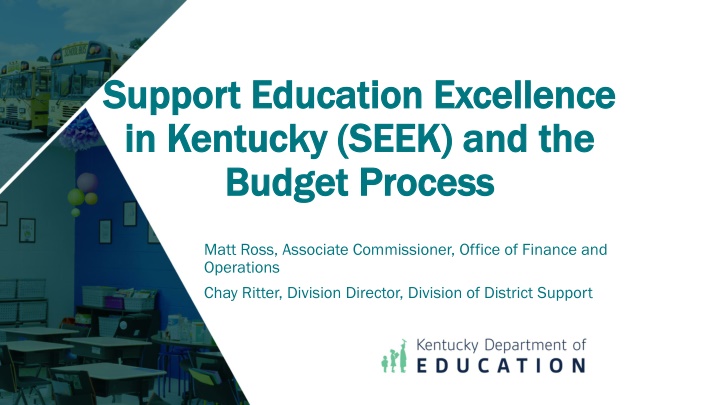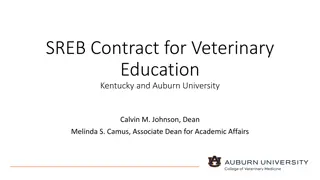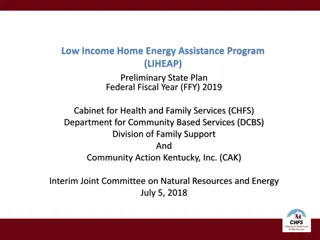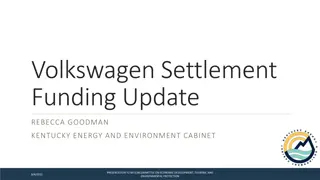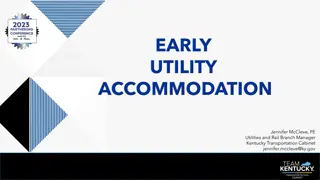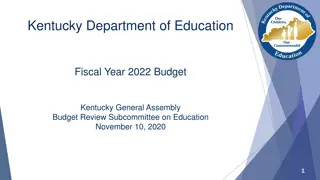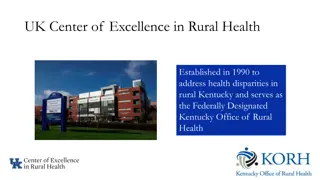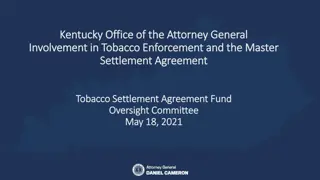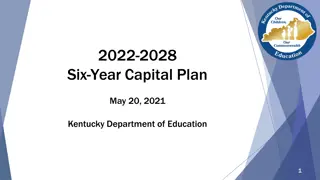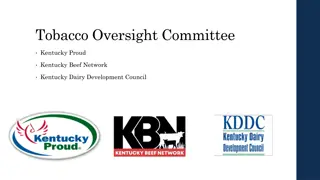Kentucky's SEEK and Budget Process
The Support Education Excellence in Kentucky (SEEK) program plays a vital role in distributing state funding to K-12 public school districts. Through a formula-driven allocation model, SEEK estimates are developed using a combination of economic data and relevant factors, such as property assessments, student populations, and external influences. These estimates are crucial in shaping education budgets for the upcoming biennium, with various aspects impacting their accuracy. Learn more about the SEEK program and its budgeting process in Kentucky.
Download Presentation

Please find below an Image/Link to download the presentation.
The content on the website is provided AS IS for your information and personal use only. It may not be sold, licensed, or shared on other websites without obtaining consent from the author.If you encounter any issues during the download, it is possible that the publisher has removed the file from their server.
You are allowed to download the files provided on this website for personal or commercial use, subject to the condition that they are used lawfully. All files are the property of their respective owners.
The content on the website is provided AS IS for your information and personal use only. It may not be sold, licensed, or shared on other websites without obtaining consent from the author.
E N D
Presentation Transcript
Support Education Excellence Support Education Excellence in Kentucky (SEEK) and the in Kentucky (SEEK) and the Budget Process Budget Process Matt Ross, Associate Commissioner, Office of Finance and Operations Chay Ritter, Division Director, Division of District Support
SEEK Formula driven allocation model that provides state funding to our K-12 Public School Districts Appropriation for SEEK and related budget units is about $2.8 billion out of a total of $3.2 billion To develop this portion of the budget, estimated data is used by the Kentucky Department of Education and the Office of the State Budget Director to build the upcoming two-year cycle of SEEK inputs used in the biennial budget These same SEEK inputs are used by the Governor, House, and Senate to develop their respective versions of the SEEK budget
How are projected estimates made? Economists with the Office of the State Budget Director (OSBD)use a combination of models and 20 years of relevant data to build estimates of SEEK inputs for the upcoming biennium KDE reviews these estimates, provides additional information that may impact these estimates and works with OSBD to finalize these estimates If agreed upon, the estimated SEEK inputs are then used to build SEEK calculations used for budgeting in the next biennium
What is estimated? Property Assessments Real Property Tangible Property Motor Vehicle Assessments Aggregate Average Daily Attendance (AADA) Fall Growth January Growth At Risk (Free Lunch)
Exceptional Child Count (Special Education Population) Low Incidence/Severe Moderate Incidence High Incidence/Speech Home/Hospital Count Limited English Proficiency Students
What can impact these estimates? Population shifts Open enrollment Birth rates Attendance percentage Weather Poverty Illness Pandemics Property transactions Tangible property (equipment) being moved in and/or out of districts Economic Development Virtual Schools Changes in state or federal education law National, State, and Local economic factors
2024-2026 Biennial Budget September 2023-April 2024 2024-2025 SEEK Funding Calculation 2025-2026 SEEK Funding Calculation Aggregate Average Daily Attendance Fall Growth Factor January Growth Factor1 Property Assessments2 1-Aug-24 1-Aug-25 1-Dec-24 1-Dec-25 1-Mar-25 1-Mar-26 1-Oct-24 1-Oct-25 At Risk (Free Lunch) Exceptional Child Count Home/Hospital Limited English Proficiency Early Graduation/KHEAA Transportation3 4% Adjusted Assessment4 Property Growth Relief5 1-Aug-24 1-Aug-25 1-Feb-24 1-Feb-25 1-Aug-24 15-Aug-24 1-Aug-25 15-Aug-25 Estimated SEEK Data Used 1-Mar-25 1-Mar-26 1-Mar-25 1-Mar-26 1-Mar-25 1-Mar-26 1-Mar-25 1-Mar-26 1Subject to available funds, KRS 157.360(16) 2Certified property assessments are provided by the Department of Revenue. In some years, the final property assessments may be certified before this date but are not included in SEEK until final calculation 3Transportation includes end of year transportation data included audited financial data. These audits are performed by independent auditors and may not be completed until on or about March 1, 2025 4 Subject to available funds, KRS 157.360(17), included in Final SEEK calculation if applicable 5Subject to available funds, HB 6 (24 RS)
How did the FY 25 estimates do? FY 25 Estimate FY 25 Actual Difference % Approximate "Cost"** AADA 590,883.1 -1,355 -0.2% $5.8 million 592,237.6 * At Risk 373,380 377,104 -3,724 -1.0% $2.4 million Exceptional Child 100,118 104,294 -4,176 -4.2% $22.1 million Home Hospital 2,606 2,877 -271 -10.4% $1.1 million Limited English 40,752 44,860 -4,108 -10.1% $1.7 million Property Assessments $473.1 Billion $474.4 Billion $1.26 Billion 0.3% $3.7 million *Does not include January Growth **It should be noted that the overall shortfall is dependent upon a calculation, not just the inputs, therefore the amounts above are offset within the formula by other SEEK budget units such as Tier I or "Nickel" appropriations
Some important information. HB 6 (2024 RS) and previous budget bills contained language which allowed the movement of funds between SEEK base and its adjustment factors if insufficient funds existed in those budget units. That language allows us to offset shortfalls which results in any shortfall or excess being a net number.
What is the current situation? The 2024-2025 SEEK Final Calculation, which will provide us with a final shortfall amount, is due to be finished on March 1, 2025 However, KDE staff are trying to complete this calculation earlier than normal As we get closer to completion, we communicate with OSBD as well as LRC staff frequently
Our net shortfall amount is currently $14.7 million. This amount is within .53% of our appropriation This is the statutorily required amount to finish SEEK for the fiscal year. There are three additional components that can be added if funds are available . If these are funded, $40.6 million would be required* *January Growth, one of those components, is not yet available nor included in that amount
Potential Impact to Districts If no action is taken, the $14.7 million will be applied to district SEEK calculations on a pro rata basis except for hold harmless districts This will appear in their April-June 2025 SEEK payments
